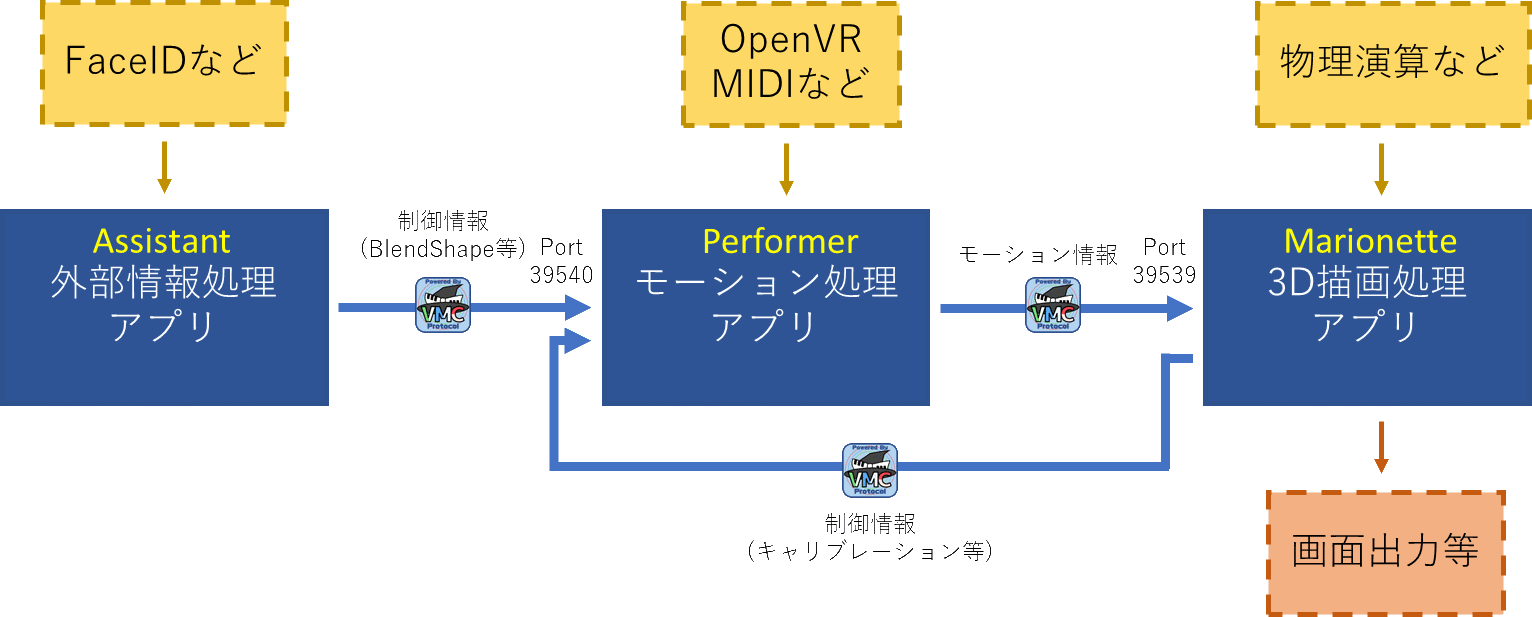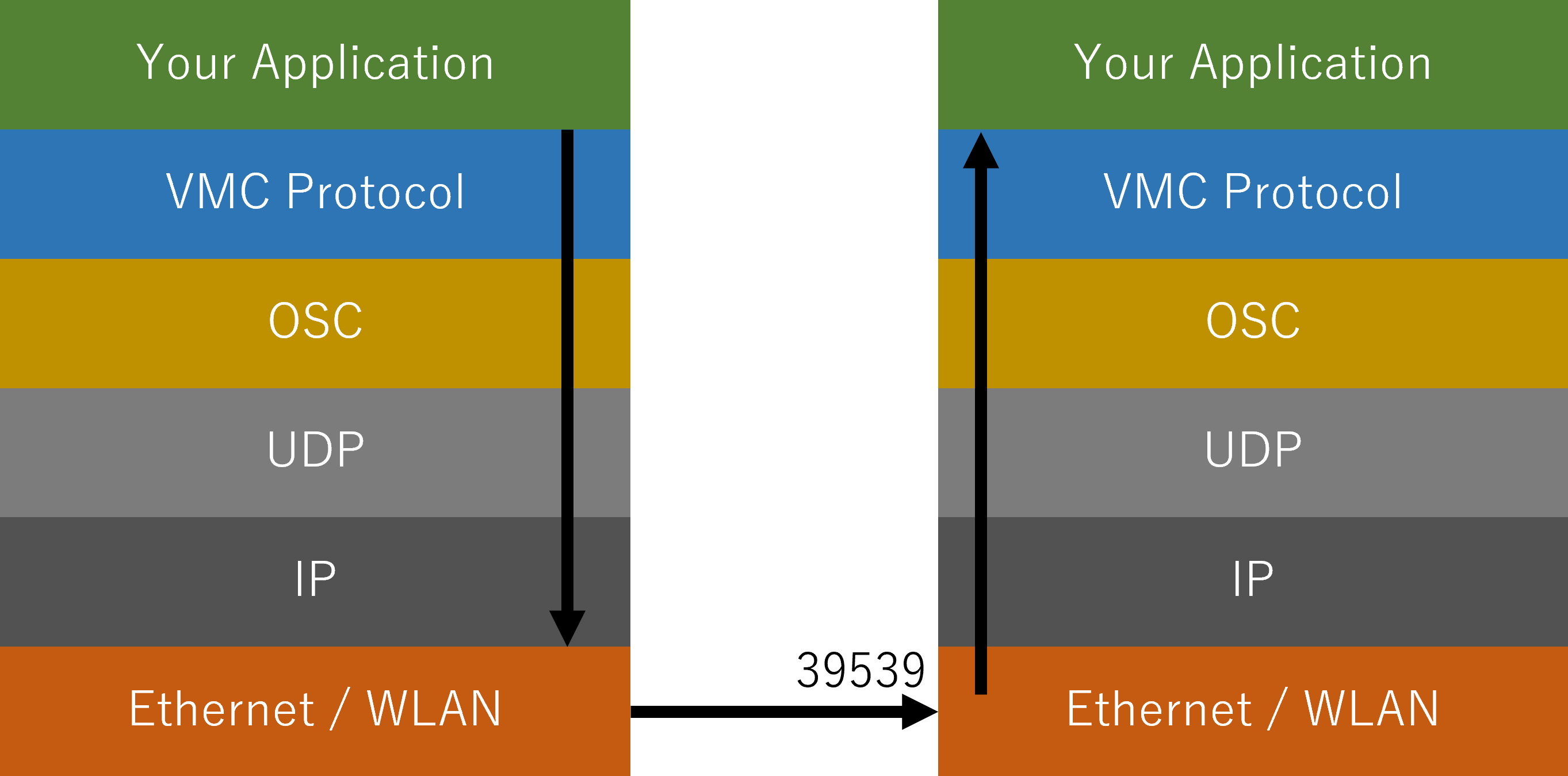406 lines
15 KiB
Markdown
406 lines
15 KiB
Markdown
# 动画方案
|
||
预制开始/等待动画 -> VMC推流动画 -> 预制结束/等待动画
|
||
## VMC推流
|
||
|
||
## 迭代动画状态机方案
|
||
1. 由ChatGPT模型AI使用之前录制动画素材拼凑出N组排列组合。
|
||
2. 动画资产以及排列数据进行定期热更新。(自动 | 人工)
|
||
3. 实时直播时由ChatGPT发送指定排列组合的名称或者ID给客户端,之后客户端播放对应的排列组合动画。
|
||
|
||
# 推流方案
|
||
推流视频:
|
||
- https://www.bilibili.com/video/BV1ub4y1Y74K/?spm_id_from=333.337.search-card.all.click&vd_source=d47c0bb42f9c72fd7d74562185cee290
|
||
- https://www.youtube.com/watch?v=ufU9me5pDYE&t=2s
|
||
|
||
# 协议
|
||
## OSC
|
||
一种基于UDP的**远程控制协议**,传输的数据主要分为Bundle 与 Message。
|
||
- OSC:https://opensoundcontrol.stanford.edu/index.html
|
||
- Nodejs的OSC实现:https://www.npmjs.com/package/osc
|
||
- 案例代码库:https://github.com/colinbdclark/osc.js-examples
|
||
|
||
### 反序列化步骤
|
||
1. 调用`ReadOSC()`
|
||
2. ReadOSCString,读取Address。主要分为`#bundle`、`#message`。
|
||
3. `#bundle`
|
||
1. 读取uint64 Time。
|
||
2. 调用`ReadOSC()`,递归序列化之后的数据。
|
||
4. `#message`:基础数据反序列化逻辑
|
||
1. 读取FString Semantics,里面每个字符代表之后基础数据的类型。
|
||
2. 根据基础数据类型进行反序列化,一个数据生成一个FUEOSCElement。
|
||
|
||
```c++
|
||
UENUM()
|
||
enum class EUEOSCElementType : uint8
|
||
{
|
||
OET_Int32 UMETA(DisplayName = "Int32"),
|
||
OET_Float UMETA(DisplayName = "Float"),
|
||
OET_String UMETA(DisplayName = "String"),
|
||
OET_Blob UMETA(DisplayName = "Blob"),
|
||
OET_Bool UMETA(DisplayName = "Bool"),
|
||
OET_Nil UMETA(DisplayName = "Nil")
|
||
};
|
||
```
|
||
|
||
### UEOSC实现分析
|
||
一个数据包的格式为:
|
||
```c++
|
||
USTRUCT(BlueprintType)
|
||
struct UEOSC_API FUEOSCMessage
|
||
{
|
||
GENERATED_USTRUCT_BODY()
|
||
|
||
public:
|
||
FString Address;
|
||
TArray<FUEOSCElement> Elements;
|
||
};
|
||
```
|
||
其中`FUEOSCElement`存储的具体数据,里面是一个结构体存储着基础数据类型数据以及数据类型枚举。
|
||
|
||
#### 基础数据类型
|
||
数据以结构体形式进行序列化/反系列化。可携带的数据类型为:
|
||
- int32、int64、uint64
|
||
- float32
|
||
- String(`FName`)
|
||
- blob(`TArray<uint8>`)
|
||
- bool
|
||
|
||
## VMC
|
||
全名为Virtual Motion Capture Protocol,一种基于OSC的虚拟偶像动作输出传输协议。
|
||
|
||
**存在问题**:
|
||
1. 数据没有压缩,不适合互联网传输。
|
||
2. 基于OSC这种UDP协议数据没有可靠性。
|
||
|
||
### 协议分析
|
||
- VMC协议可视化工具:https://github.com/gpsnmeajp/VMCProtocolMonitor
|
||
- https://protocol.vmc.info/specification
|
||
- performer-spec:https://protocol.vmc.info/performer-spec
|
||
- marionette-spec:https://protocol.vmc.info/marionette-spec
|
||
|
||
VMC协议基本上实现了开放声音控制(OSC)单向UDP通信来进行通信。
|
||
|
||
因此,VMC 协议定义了自己的术语:
|
||
- **木偶**(**Marionette**)
|
||
- 接收动作、绘制等。(必填)
|
||
- 它的存在最终是为了在屏幕、视频、通讯上产生结果。
|
||
(示例:EVMC4U、VMC4UE、其他运动接收兼容应用程序)
|
||
- **表演者**(**performer**)
|
||
- 主要处理运动并向 Marionette 发送**全身骨骼信息 (IK)** 和**辅助信息**。(必填)
|
||
- (例如虚拟动作捕捉、Waidayo、VSeeFace、MocapForAll、TDPT 等)
|
||
- **助理**(**Assistant**)
|
||
- 主要不处理动作并向表演者发送辅助信息。(可选)
|
||
- 仅负责**发送辅助**信息。(**一些骨骼、跟踪器姿势、面部表情**等)
|
||
(例如,face2vmc 模式下的 Waidayo、Sknuckle、Simple Motion Tracker、Uni-studio 等)
|
||
|
||
具体沟通规定如下:
|
||
- 通信时使用适当类型的 OSC。
|
||
- 字符串采用 UTF-8 编码,可以用日语发送。
|
||
- 至于端口号,Marionette 将监听端口:39539,而 Performer 将监听端口:39540,但从 UX 角度来看,我们建议您更改发送地址
|
||
和接收端口。
|
||
- 数据包在适当的范围内(1500 字节以内)进行捆绑,并且应由接收方进行适当的处理。
|
||
- 传输周期以发送方的任意间隔执行。并非所有消息都会在每个周期发送。
|
||
另外,发送方应该能够调整发送周期的间隔,或者以足够低的频率发送。
|
||
- 接收方应丢弃不必要的消息。您不必处理所有消息。
|
||
- 发送或接收哪些消息取决于两者的实现。
|
||
- 未知地址,应忽略太多参数。
|
||
- 如果您发现参数太少或类型与扩展规范中定义的参数不同,请将它们视为错误或忽略它们。
|
||
|
||

|
||

|
||
|
||
### performer-spec
|
||
这是`Marionette→Performer`或`Assistent→Performer`流程中的发送数据的规范。
|
||
|
||
主要有:
|
||
- 虚拟设备转换
|
||
- 帧周期
|
||
- 虚拟 MIDI CC 值输入
|
||
- 虚拟摄像机变换和 FOV
|
||
- VRM BlendShapeProxyValue
|
||
- 眼动追踪目标位置
|
||
- [事件发送]信息发送请求(Request Information)
|
||
- [事件传输] 响应字符串
|
||
- [事件发送] 校准(准备)请求(校准/校准就绪请求)
|
||
- [事件发送]请求加载设置文件
|
||
- 通过信息
|
||
- DirectionalLight 位置/颜色(DirectionalLight 变换和颜色)
|
||
- [事件传输] 快捷调用(Call Shortcut)
|
||
|
||
#### 虚拟设备转换
|
||
主要为:虚拟头显、控制器Controller和追踪器Track。(HMD被视为跟踪器)
|
||
结构为:虚拟序列号 -> Position ->Quaternion
|
||
```json
|
||
V2.3
|
||
/VMC/Ext/Hmd/Pos (string){serial} (float){p.x} (float){p.y} (float){p.z} (float){q.x} (float){q.y} (float){q.z} (float){q.w}
|
||
/VMC/Ext/Con/Pos (string){serial} (float){p.x} (float){p.y} (float){p.z} (float){q.x} (float){q.y} (float){q.z} (float){q.w}
|
||
/VMC/Ext/Tra/Pos (string){serial} (float){p.x} (float){p.y} (float){p.z} (float){q.x} (float){q.y} (float){q.z} (float){q.w}
|
||
```
|
||
|
||
#### 帧周期
|
||
设置虚拟动作捕捉的数据传输间隔。 以 1/x 帧间隔发送。
|
||
```json
|
||
V2.3
|
||
/VMC/Ext/Set/Period (int){Status} (int){Root} (int){Bone} (int){BlendShape} (int){Camera} (int){Devices}
|
||
```
|
||
|
||
### marionette-spec
|
||
这是`Performer → Marionette`流程中的发送数据的规范。
|
||
- 内容:基础状态描述,校准状态、校准模式、追踪状态
|
||
- 发送者相对时间(Time)
|
||
- 根变换
|
||
- 骨骼变换
|
||
- VRM BlendShapeProxyValue
|
||
- 相机位置/FOV(相机变换和FOV)
|
||
- 控制器输入
|
||
- [事件传输]键盘输入
|
||
- [事件传输] MIDI 音符输入
|
||
- [事件传输] MIDI CC 值输入
|
||
- [事件传输] MIDI CC 按钮输入
|
||
- 设备改造
|
||
- [低频] 接收使能
|
||
- [低频] DirectionalLight 位置/颜色(DirectionalLight 变换和颜色)
|
||
- [低频]本地VRM信息
|
||
- [低频]远程VRM基本信息
|
||
- [低频] 选项字符串
|
||
- [低频]背景色
|
||
- [低频]窗口属性信息
|
||
- [低频]加载设置路径
|
||
- 通过信息
|
||
|
||
### 根骨骼变换
|
||
```json
|
||
v2.0
|
||
/VMC/Ext/Root/Pos (string){name} (float){p.x} (float){p.y} (float){p.z} (float){q.x} (float){q.y} (float){q.z} (float){q.w}
|
||
|
||
v2.1
|
||
/VMC/Ext/Root/Pos (string){name} (float){p.x} (float){p.y} (float){p.z} (float){q.x} (float){q.y} (float){q.z} (float){q.w} (float){s.x} (float){s.y} (float){s.z} (float){o.x} (float){o.y} (float){o.z}
|
||
```
|
||
p=位置 q=旋转(四元数) s=MR 合成的比例 o=MR 合成的偏移
|
||
|
||
作为模型根的对象的绝对姿势
|
||
名称固定为“root”。 建议将
|
||
前半部分视为Position,后半部分视为接收侧Loal姿势的四元数(以与Bone匹配)。
|
||
|
||
从 v2.1 开始,添加了 MR 合成的比例。
|
||
通过使用它,可以将虚拟人物的位置和大小调整为实际的身体尺寸。
|
||
|
||
### 骨骼变换
|
||
```json
|
||
/VMC/Ext/Bone/Pos (string){name} (float){p.x} (float){p.y} (float){p.z} (float){q.x} (float){q.y} (float){q.z} (float){q.w}
|
||
```
|
||
|
||
作为模型根的对象的局部姿势名称
|
||
是UnityEngine沿HumanBodyBones的类型名称
|
||
前半部分是Position,后半部分是Quaternion
|
||
|
||
所有 HumanBodyBone 都将被发送。还包括 LastBone。 这还将传输手指运动和眼骨。
|
||
|
||
## UE Remote Control
|
||
https://docs.unrealengine.com/5.1/en-US/remote-control-for-unreal-engine/
|
||
|
||
基于WebSocket
|
||
|
||
# VMC4UE的实现
|
||
## AnimNode
|
||
实现:
|
||
- FAnimNode_ModifyVMC4UEBones
|
||
- FAnimNode_ModifyVMC4UEMorph
|
||
|
||
![[AnimNode]]
|
||
|
||
# VMC APP代码参考
|
||
- [VirtualMotionCaptureProtocol](https://github.com/sh-akira/VirtualMotionCaptureProtocol)提供了最基础的实现。
|
||
- ~~[EasyVirtualMotionCaptureForUnity](https://github.com/gpsnmeajp/EasyVirtualMotionCaptureForUnity)~~
|
||
- ThirdParts
|
||
- https://github.com/digital-standard/ThreeDPoseTracker
|
||
- 逻辑在VMCPBonesSender.cs、uOscClientTDP.cs
|
||
- BufferSize = 8192;int MaxQueueSize = 100;
|
||
|
||
## VirtualMotionCaptureProtocol
|
||
Message方式:
|
||
```c#
|
||
void Update()
|
||
{
|
||
//モデルが更新されたときのみ読み込み
|
||
if (Model != null && OldModel != Model)
|
||
{
|
||
animator = Model.GetComponent<Animator>();
|
||
blendShapeProxy = Model.GetComponent<VRMBlendShapeProxy>();
|
||
OldModel = Model;
|
||
}
|
||
|
||
if (Model != null && animator != null && uClient != null)
|
||
{
|
||
//Root
|
||
var RootTransform = Model.transform;
|
||
if (RootTransform != null)
|
||
{
|
||
uClient.Send("/VMC/Ext/Root/Pos",
|
||
"root",
|
||
RootTransform.position.x, RootTransform.position.y, RootTransform.position.z,
|
||
RootTransform.rotation.x, RootTransform.rotation.y, RootTransform.rotation.z, RootTransform.rotation.w);
|
||
}
|
||
|
||
//Bones
|
||
foreach (HumanBodyBones bone in Enum.GetValues(typeof(HumanBodyBones)))
|
||
{
|
||
if (bone != HumanBodyBones.LastBone)
|
||
{
|
||
var Transform = animator.GetBoneTransform(bone);
|
||
if (Transform != null)
|
||
{
|
||
uClient.Send("/VMC/Ext/Bone/Pos",
|
||
bone.ToString(),
|
||
Transform.localPosition.x, Transform.localPosition.y, Transform.localPosition.z,
|
||
Transform.localRotation.x, Transform.localRotation.y, Transform.localRotation.z, Transform.localRotation.w);
|
||
}
|
||
}
|
||
}
|
||
|
||
//ボーン位置を仮想トラッカーとして送信
|
||
SendBoneTransformForTracker(HumanBodyBones.Head, "Head");
|
||
SendBoneTransformForTracker(HumanBodyBones.Spine, "Spine");
|
||
SendBoneTransformForTracker(HumanBodyBones.LeftHand, "LeftHand");
|
||
SendBoneTransformForTracker(HumanBodyBones.RightHand, "RightHand");
|
||
SendBoneTransformForTracker(HumanBodyBones.LeftFoot, "LeftFoot");
|
||
SendBoneTransformForTracker(HumanBodyBones.RightFoot, "RightFoot");
|
||
|
||
//BlendShape
|
||
if (blendShapeProxy != null)
|
||
{
|
||
foreach (var b in blendShapeProxy.GetValues())
|
||
{
|
||
uClient.Send("/VMC/Ext/Blend/Val",
|
||
b.Key.ToString(),
|
||
(float)b.Value
|
||
);
|
||
}
|
||
uClient.Send("/VMC/Ext/Blend/Apply");
|
||
}
|
||
|
||
//Available
|
||
uClient.Send("/VMC/Ext/OK", 1);
|
||
}
|
||
else
|
||
{
|
||
uClient.Send("/VMC/Ext/OK", 0);
|
||
}
|
||
uClient.Send("/VMC/Ext/T", Time.time);
|
||
|
||
//Load request
|
||
uClient.Send("/VMC/Ext/VRM", filepath, "");
|
||
}
|
||
|
||
void SendBoneTransformForTracker(HumanBodyBones bone, string DeviceSerial)
|
||
{
|
||
var DeviceTransform = animator.GetBoneTransform(bone);
|
||
if (DeviceTransform != null) {
|
||
uClient.Send("/VMC/Ext/Tra/Pos",
|
||
(string)DeviceSerial,
|
||
(float)DeviceTransform.position.x,
|
||
(float)DeviceTransform.position.y,
|
||
(float)DeviceTransform.position.z,
|
||
(float)DeviceTransform.rotation.x,
|
||
(float)DeviceTransform.rotation.y,
|
||
(float)DeviceTransform.rotation.z,
|
||
(float)DeviceTransform.rotation.w);
|
||
}
|
||
}
|
||
```
|
||
|
||
Bundle将数据打包成一个Bundle,创建Bundle时会填入一个时间戳。之后
|
||
```c#
|
||
foreach (HumanBodyBones bone in Enum.GetValues(typeof(HumanBodyBones)))
|
||
{
|
||
...
|
||
boneBundle.Add(new Message("/VMC/Ext/Bone/Pos",
|
||
bone.ToString(),
|
||
Transform.localPosition.x, Transform.localPosition.y, Transform.localPosition.z,
|
||
Transform.localRotation.x, Transform.localRotation.y, Transform.localRotation.z, Transform.localRotation.w));
|
||
...
|
||
}
|
||
```
|
||
Bundle方式:
|
||
```c#
|
||
void Update()
|
||
{
|
||
//Only model updated
|
||
if (Model != null && OldModel != Model)
|
||
{
|
||
animator = Model.GetComponent<Animator>();
|
||
blendShapeProxy = Model.GetComponent<VRMBlendShapeProxy>();
|
||
OldModel = Model;
|
||
}
|
||
|
||
if (Model != null && animator != null && uClient != null)
|
||
{
|
||
//Root
|
||
var RootTransform = Model.transform;
|
||
if (RootTransform != null)
|
||
{
|
||
uClient.Send("/VMC/Ext/Root/Pos",
|
||
"root",
|
||
RootTransform.position.x, RootTransform.position.y, RootTransform.position.z,
|
||
RootTransform.rotation.x, RootTransform.rotation.y, RootTransform.rotation.z, RootTransform.rotation.w);
|
||
}
|
||
|
||
//Bones
|
||
var boneBundle = new Bundle(Timestamp.Now);
|
||
foreach (HumanBodyBones bone in Enum.GetValues(typeof(HumanBodyBones)))
|
||
{
|
||
if (bone != HumanBodyBones.LastBone)
|
||
{
|
||
var Transform = animator.GetBoneTransform(bone);
|
||
if (Transform != null)
|
||
{
|
||
boneBundle.Add(new Message("/VMC/Ext/Bone/Pos",
|
||
bone.ToString(),
|
||
Transform.localPosition.x, Transform.localPosition.y, Transform.localPosition.z,
|
||
Transform.localRotation.x, Transform.localRotation.y, Transform.localRotation.z, Transform.localRotation.w));
|
||
}
|
||
}
|
||
}
|
||
uClient.Send(boneBundle);
|
||
|
||
//Virtual Tracker send from bone position
|
||
var trackerBundle = new Bundle(Timestamp.Now);
|
||
SendBoneTransformForTracker(ref trackerBundle, HumanBodyBones.Head, "Head");
|
||
SendBoneTransformForTracker(ref trackerBundle, HumanBodyBones.Spine, "Spine");
|
||
SendBoneTransformForTracker(ref trackerBundle, HumanBodyBones.LeftHand, "LeftHand");
|
||
SendBoneTransformForTracker(ref trackerBundle, HumanBodyBones.RightHand, "RightHand");
|
||
SendBoneTransformForTracker(ref trackerBundle, HumanBodyBones.LeftFoot, "LeftFoot");
|
||
SendBoneTransformForTracker(ref trackerBundle, HumanBodyBones.RightFoot, "RightFoot");
|
||
uClient.Send(trackerBundle);
|
||
|
||
//BlendShape
|
||
if (blendShapeProxy != null)
|
||
{
|
||
var blendShapeBundle = new Bundle(Timestamp.Now);
|
||
|
||
foreach (var b in blendShapeProxy.GetValues())
|
||
{
|
||
blendShapeBundle.Add(new Message("/VMC/Ext/Blend/Val",
|
||
b.Key.ToString(),
|
||
(float)b.Value
|
||
));
|
||
}
|
||
blendShapeBundle.Add(new Message("/VMC/Ext/Blend/Apply"));
|
||
uClient.Send(blendShapeBundle);
|
||
}
|
||
|
||
//Available
|
||
uClient.Send("/VMC/Ext/OK", 1);
|
||
}
|
||
else
|
||
{
|
||
uClient.Send("/VMC/Ext/OK", 0);
|
||
}
|
||
uClient.Send("/VMC/Ext/T", Time.time);
|
||
|
||
//Load request
|
||
uClient.Send("/VMC/Ext/VRM", vrmfilepath, "");
|
||
|
||
}
|
||
|
||
``` |